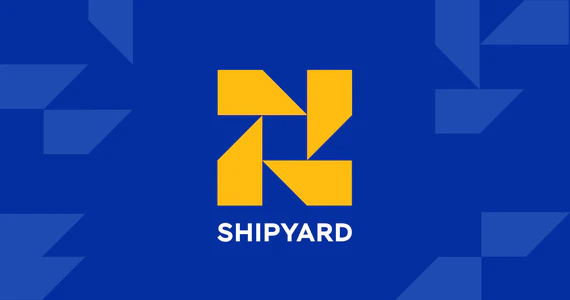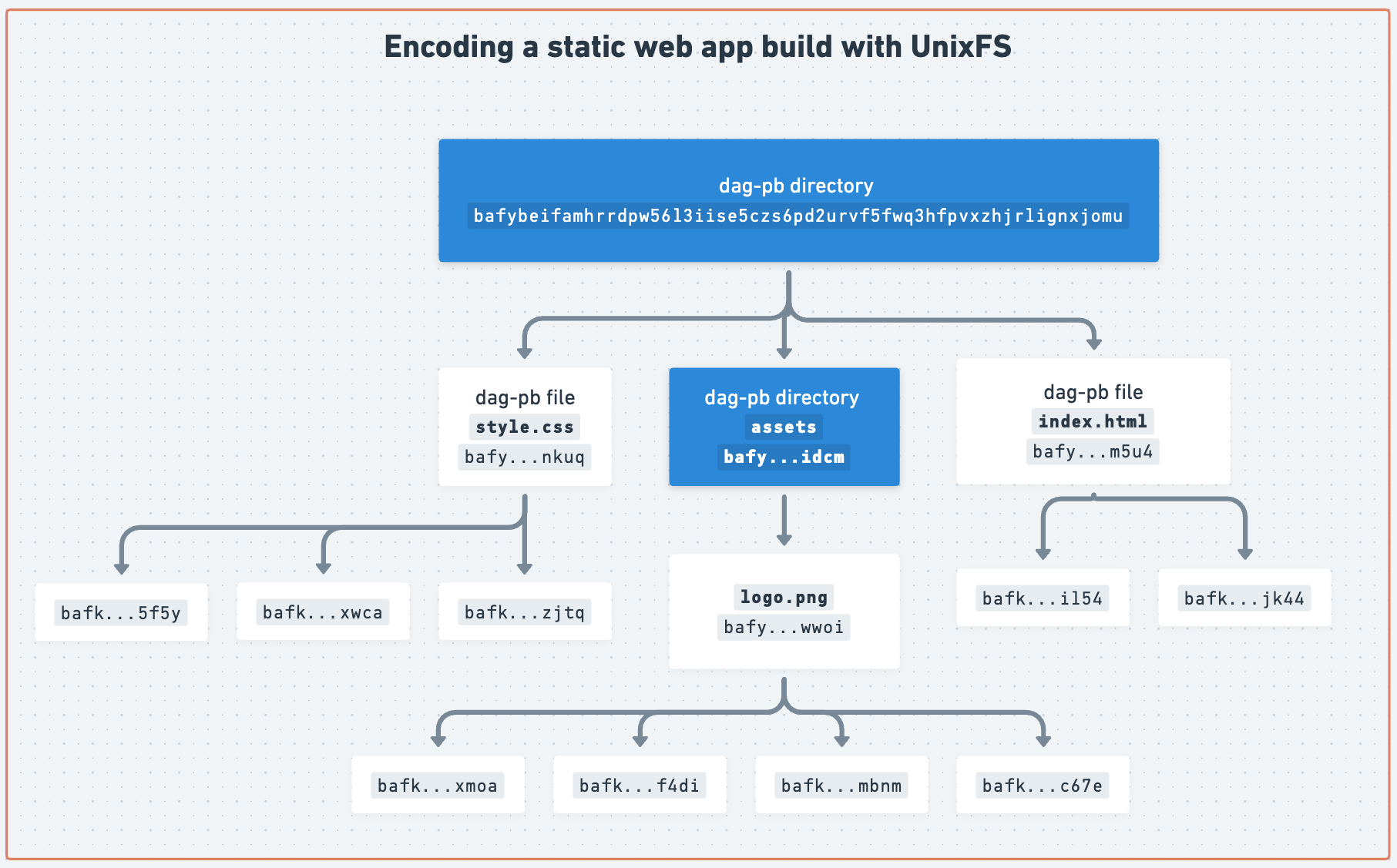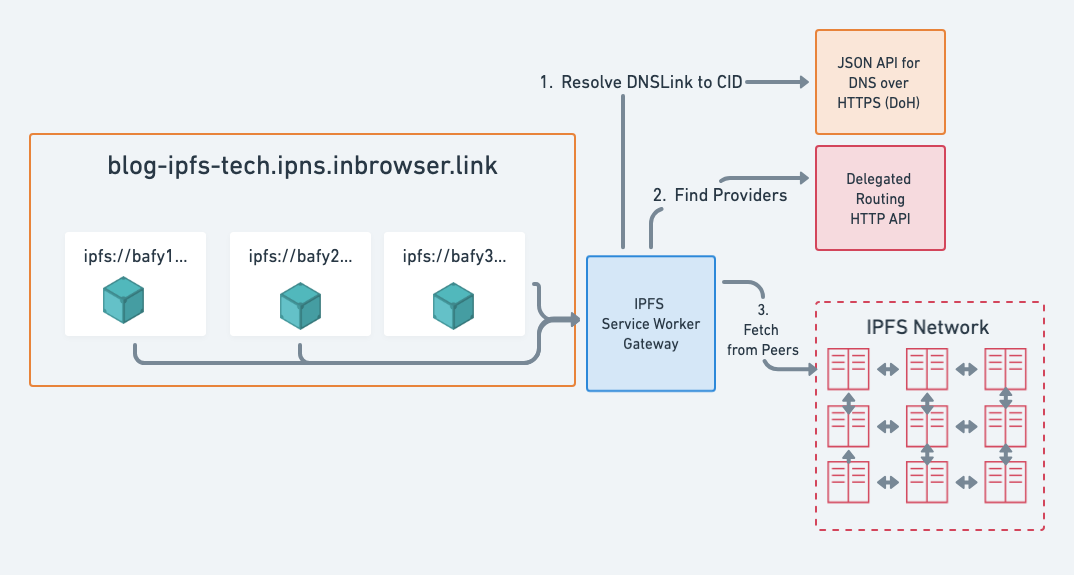
IPFS & libp2p Devs Go Independent: Meet Interplanetary Shipyard
Meet the team behind Interplanetary Shipyard, the newly created entity of many core maintainers behind the most popular implementations of IPFS and libp2p.

Earlier this year, we introduced Interplanetary Shipyard , as the evolution of the maintainers leading the open-source development of libp2p and the most popular IPFS implementations, tooling and infrastructure.
In our introduction, we shared our roadmap and vision, a key part of which is to make IPFS work on the web.
In this blog post, we’ll share all the progress we’ve made since then and what we have planned for the future.
For as long as IPFS has existed, one of the key goals has been to make it possible to use IPFS on the web. That is, resilient, decentralized, and verified data retrieval on the Web.
But what does it mean for IPFS to work on the Web?
Resilient: Data is retrievable in a browser even if some providers go offline. Decentralized: You can connect to other peers from a browser for content routing and retrieval while immune to censorship and chokepoints that disrupt the network. Verified: You verify data locally, ensuring integrity without assuming trust (aka trustless).
Data refers to anything that can be addressed by a CID: files, directories, web apps/dapps, videos, etc.
While the Web platform has by far the widest reach, it’s also the most challenging platform to make IPFS work on due to the inherent constraints of the platform and the discrepancies between browsers.
Gateways like ipfs.io are a double-edged sword, because they make IPFS content accessible to the web, but they also highlight the challenges of IPFS on the web. Initially conceived as a crutch to bootstrap the network until a more decentralized and resilient solution was in place, public gateways became entrenched as the default to access IPFS content on the web to the detriment of the principles of IPFS.
At Interplanetary Shipyard , we’ve been tackling this challenge head on with a number of projects across the libp2p and IPFS stacks to make IPFS on the web a reality:
Let’s take a look at each of these projects in more detail.
Verified Fetch is a TypeScript library for verified retrieval of IPFS content we released earlier this year and built on top of Helia . We designed it to make IPFS retrieval by CID as easy as the Fetch API that most developers are already familiar with. We focused on getting a seamless developer experience with a simple API, while abstracting away all the complexities of IPFS: content routing, transports, and verification.
Verified Fetch works great for loading content-addressed static assets or sub-resources asynchronously as part of a web app or dapp, for example, images, videos, or JSON.
From a developer experience standpoint, Verified Fetch follows the following pattern:
Response objectThis foundational API surface, while simple, enables a wide range of retrieval use-cases while abstracting away the complexities of data types, content routing, transports and verification. Moreover, returning a Response object allows for easy integration with the browser’s caching mechanisms and use in Service Workers
.
Verified Fetch is great for loading content-addressed static assets or “sub-resources” asynchronously, for example, images, videos and even IPLD encoded data.
See the Pen @helia/verified-fetch Direct Retrieval with Libp2p by Daniel Norman (@2color) on CodePen.
But what about loading full dapps or websites from IPFS? Unlike static assets, web apps and websites require a way to resolve standard URLs to their corresponding content addressed resources.
This is where the Service Worker Gateway comes in, which builds on top of Verified Fetch.
The Service Worker Gateway is a Web native IPFS gateway that runs in the browser. It implements the IPFS Gateway spec in a Service Worker and fetches IPFS content directly from providers on the network in addition to verifying it locally.
In a previous blog post , we looked at how web publishing works with IPFS. This can be summarized as:

The Service Worker Gateway unleashes new possibilities for decentralized web publishing:
For example, the IPFS blog is statically generated and has a distinct CID for each version. With the help of Fleek, each build is encoded with UnixFS, given a CID and provided to the IPFS network. The DNSLink record is also updated to the latest release CID.
Now, instead of using a trusted gateway, e.g. https://blog-ipfs-tech.ipns.dweb.link/, you can load the blog using the Service Worker Gateway at blog-ipfs-tech.ipns.inbrowser.link
.

Note: There’s an inherent trade off with the Service Worker Gateway: it requires an initial upfront cost of fetching and installing the Service Worker which fetches and verifies data. This is why the first load may be slower than using a trusted gateway.
The Service Worker Gateway also highlights the focus on composability across the JavaScript/TypeScript implementations of IPFS and libp2p:
The Service Worker Gateway depends on Verified Fetch , which depends on Helia which depends on js-libp2p .

As we embarked on this project, we focused on getting the basics right:
Note: There’s a subtle difference between recursive gateways and HTTP gateway providers. Recursive gateways, like
ipfs.ioandtrustless-gateway.link, will fetch content by CID from providers when the content is not locally available. HTTP gateway providers on the other hand, are IPFS HTTP gateways discovered via the IPNI (with thetransport-ipfs-gateway-httpprotocol) that only return blocks for CIDs they have.
Over the last few months, we’ve been improving the reliability and user experience. Most importantly, we’ve added support for direct peer-to-peer retrieval with js-libp2p under the hood. This means that the Service Worker Gateway can now leverage a broader set of provider peers that have either WebTransport or Secure WebSocket enabled.
This brings us to the next topic: browser transports, which play a crucial role in making both IPFS and libp2p on the web a reality.
Browser transports (protocols) are the bread and butter of the web and the Achilles heel of IPFS on the web. If you can’t communicate with other peers, you can’t do much.
Browsers communicate over the internet using a number of transport protocols, each with their own strengths and weaknesses. Assuming a web app is in a Secure Context , i.e., served over HTTPS as most modern web apps are, the following transport protocols are available:
The following table summarizes the capabilities of each transport:
| Bi-directional streaming | Requires TLS Certificate and domain | Widely supported | Useable in Service Worker | Browser-to-Browser | |
|---|---|---|---|---|---|
| HTTPS | ❌ | ✅ | ✅ | ✅ | ❌ |
| Secure WebSocket | ✅ | ✅ | ✅ | ✅ | ❌ |
| WebRTC | ✅ | ❌ | ✅ | ❌ | ✅ |
| WebTransport | ✅ | ❌ | ❌ | ✅ | ❌ |
Note: while streaming is technically possible with HTTPS, browsers don’t allow reading from the response until the request has been fully sent. See this issue for more details.
HTTP is widely supported in browsers and implementations of IPFS. Perhaps most common is the IPFS HTTP Gateway , a general purpose retrieval API with HTTP semantics that is broadly used in IPFS implementations, tooling and infrastructure.
Request/response protocols like HTTP are not very well suited for streaming protocols like Bitswap . WebSocket (and WebRTC and WebTransport), are bi-directional streaming protocols and are well suited for libp2p based protocols like Bitswap. What’s more, WebSockets are supported in all modern browsers and are compatible with Service Workers.
Where things get slightly tricky is TLS for both HTTP and WebSockets, i.e. HTTPS and Secure WebSockets, which are required by Secure Contexts and Service Workers.
HTTPS and Secure WebSockets require a CA-signed TLS certificate and a domain, which most peers in the IPFS network do not have by default.
To address this, we’ve been working on a project to automate the issuance of wildcard Let’s Encrypt TLS certificates for all publicly dialable IPFS nodes. More on that in the AutoTLS section below.
WebRTC is a browser-to-browser communication protocol, e.g. for video, audio, and data streaming.
In the context of IPFS and libp2p, there are two implementations of WebRTC :
The spec for WebRTC for browser-to-browser communication in libp2p was ratified last year and includes a decentralized signalling mechanism for exchanging SDPs that leverages Circuit Relays. We’ve written an extensive guide to help you get started and also ran a workshop at IPFS Camp. It’s also used by Universal Connectivity and IPFS Share to demonstrate the possibilities of browser-to-browser communication.
We’ve also seen the ecosystem thrive with projects like Topology , OrbitDB , and Canvas that rely on js-libp2p and WebRTC as the foundation for their browser-to-browser communication.
It’s also worth noting that WebRTC is the only browser transport with a mechanism for NAT hole-punching, which is the process of establishing a direct connection between two peers through a network address translator (NAT). This is a crucial part of establishing a direct connection between two peers in a decentralized network like IPFS.
WebRTC-Direct was designed a transport protocol to allow browser-to-server communication without the need for a domain name and CA-signed TLS certificates.
WebRTC-direct is stable as of go-libp2p v0.36.1 and enabled by default in Kubo as of 0.30.0 .
This is a huge milestone, because it means that browsers can dial publicly reachable IPFS nodes with WebRTC-direct enabled without TLS certificates or domain names. We therefore recommend upgrading to the latest version of Kubo to take advantage of this.
There are two caveats with WebRTC in browsers:
Two years ago, the IPFS and libp2p projects made a bet on the promise of WebTransport and it’s been a bumpy road. WebTransport is a promising protocol, especially for libp2p and IPFS, because it allows bi-directional streaming communication with many modern improvements over WebSockets, without the need for CA-signed certificates and a domain. This was a game changer, since most peers in the IPFS network do not have a domain name.
However, the WebTransport specification is still in draft, and browser implementations have had a number of bugs and issues , that we’ve been working with the browser vendors to address. As such, browser compatibility breaks as soon as the interoperability target changes.
While we still believe in the longer term promise of WebTransport, we’ve reoriented our immediate priorities to WebRTC-Direct (which is now available) and Secure WebSockets (see AutoTLS below) . Nonetheless, we continue to work with browser vendors and standard bodies to get WebTransport to a stable and interoperable state.
AutoTLS is a new feature that significantly improves how browsers (Helia, Service Worker) can connect to Kubo nodes.
As mentioned above, Secure WebSockets is the only streaming transport that works reliably in Service Workers, but requires a TLS certificate and domain.
To overcome this, the Shipyard team has been working on a project to automate the issuance of wildcard TLS certificates for publicly dialable Kubo nodes. This way, nodes can use Secure WebSockets libp2p transport without needing to register a domain name.
We call this service AutoTLS and it’s powered by the libp2p.direct domain.
AutoTLS
enables publicly reachable Kubo nodes, i.e. nodes dialable from the public internet, to get a wildcard TLS certificate unique to their PeerID at *.<PeerID>.libp2p.direct without needing to register and configure a domain name. This enables direct libp2p connections and direct retrieval of IPFS content from browsers using Secure WebSockets.
Under the hood, the infrastructure behind libp2p.direct has two roles:
*.[PeerID].libp2p.direct. To do so it authenticates PeerIDs requesting certificates, verifies their network reachability and sets the TXT DNS record for the ACME challenge
at _acme-challenge.<PeerID>.libp2p.direct.*.libp2p.direct. Notably, the IP addresses it resolves to are encoded in the DNS name, e.g. 1-2-3-4.<peerID>.libp2p.direct resolves to the A record with the IP 1.1.1.1. This keeps the DNS server stateless and simple to operate while ensuring that even when a Kubo node’s IP address changes, it’s resolvable without coordination.Note: AutoTLS is not a replacement for Let’s Encrypt or other TLS certificate authorities. It’s a complementary service for getting a TLS certificate for your Kubo node’s unique PeerID without the need for your own domain name.
AutoTLS is provided as a public good service and operated by Interplanetary Shipyard and is available on an opt-in basis with Kubo 0.32.1 .
We’re also adding support for AutoTLS in js-libp2p , which would allow the JavaScript ecosystem to also reap the benefits of AutoTLS.
AutoTLS is available in Kubo v0.32.1 or IPFS Desktop v0.40.0 (which includes Kubo). We encourage you to try it out and share your feedback .
A theme that runs through many of the projects in this blog post is the use of HTTP as the blueprint for interoperability.
This is driven by the following reasons:
More about this in a recent talk from IPFS Camp:
Along with the new browser transports, we’ve also been working on a number of developer tools to make it easier to debug web applications that rely on libp2p and IPFS. Historically, debugging IPFS and libp2p in the browser meant enabling logging and then grepping through the logs.
We’ve now released a browser extension that allows you to inspect the libp2p node and interact with it straight from the browser developer tools.
So how does it work? The browser extension pairs with a metrics implementation that you add to your js-libp2p node. The extension then fetches the metrics from the node over RPC and displays them in the browser developer tools.
This relies on the same metrics interface that js-libp2p exposes, which can also be used for monitoring js-libp2p with Prometheus (in Node.js)
Learn more about the browser extension in this talk from IPFS Camp:
The Delegated Content Routing HTTP API allows IPFS nodes to offload content and peer routing to another process/server using an HTTP API. In addition, it allows for composability and experimentation with different routing systems.
Since the spec was ratified in 2022 , it’s been positively received and gradually implemented and integrated in the ecosystem:
https://delegated-ipfs.dev/routing/v1 that is operated by Interplanetary Shipyard./routing/v1/providers endpoint for finding providers for a CID.The Distributed Hash Table (DHT) is the default routing system for IPFS and is used for finding peers and providers for CIDs in the network. Traversing the DHT however requires opening connections to around log₂(N) peers in the network, where N is the total number of peers. For a network such as IPFS, this can easily mean establishing connections to tens of peers just to find a single provider.
The Delegated Routing HTTP API empowers resource constrained clients like web browsers by significantly reducing the number of network connections necessary to fetch content addressed data directly from provider peers.
In other words, you can reduce the number of connections to 1 by offloading routing to another process/server using the HTTP API, e.g. the public goods endpoint at https://delegated-ipfs.dev/routing/v1.
There are many cases where most of the results from the Delegated Routing HTTP API are not actionable by clients, because the client does not support either the network transport protocol, e.g. TCP, or the transfer protocol, e.g. GraphSync.
IPIP-484 introduces filtering for Provider and Peer records, which allows for more efficient routing. For browsers, IPIP-484 reduces the overhead of unactionable results returned by the API. For Kubo it means less load establishing connections to peer that only support GraphSync. Moreover, it makes manual debugging easier with the filters in the query parameters.
IPIP-484 is already implemented in Boxo SDK, someguy , Helia , Kubo , and Rainbow .
Bitswap is the most prevalent data transfer protocol in the IPFS network. Our experience operating the public IPFS Gateways on behalf of the IPFS Foundation gives us an opportunity to measure and optimize Bitswap at scale.
Based on tracing and metrics from the public IPFS Gateways, we’ve identified and released a number of performance improvements to the Go implementation of Bitswap in Boxo , which is used by Kubo and Rainbow.
Libp2p is a dependency of most of the above projects and is the bedrock of the entire IPFS stack.
Beyond the work mentioned earlier on transports, we’ve also been working on numerous improvements and specs to libp2p that support the above projects. Check out the js-libp2p Roadmap for more details.
AutoNAT v2 is a new version of the AutoNAT protocol that provides more precise reachability information for nodes.
It provides higher granularity in determining reachability for the node, e.g. AutoNAT v2 allows us to determine reachability for all combinations of (ipv4/ipv6, tcp/udp).
AutoNAT v2 is implemented in go-libp2p and the rollout to the public swarm started in Kubo v0.30.0 .
While not directly related to IPFS on the web, AutoNAT v2 improves the network layer of non-browser IPFS nodes, which is a crucial part of the IPFS network infrastructure.
A number of fixes and improvements to NAT hole punching have been implemented in go-libp2p which should help improve connectivity of IPFS nodes behind NATs.
Note: NAT hole punching in browsers is different from NAT hole punching in QUIC and TCP. Browsers use ICE with STUN servers for WebRTC NAT traversal , while non-browser libp2p peers use Circuit Relay v2 and DCUtR .
The js-libp2p Amino DHT Bootstrapper is a new Amino DHT bootstrapper like the go-libp2p and rust-libp2p, but implemented in js-libp2p.
Beyond the obvious benefit of having another bootstrapper as a public good, it also allows us to stress test js-libp2p with high traffic. By monitoring with Prometheus, we’ve been able to find and resolve a number of bugs in several js-libp2p packages.
The bootstrapper supports TCP and Secure WebSockets and can be connected to at /dnsaddr/va1.bootstrap.libp2p.io/p2p/12D3KooWKnDdG3iXw9eTFijk3EWSunZcFi54Zka4wmtqtt6rPxc8.
Libp2p over HTTP defines how libp2p peers can use and expose libp2p protocols over HTTP. This has the benefit of allowing a wider variety of nodes to participate in the libp2p network, in addition to providing more interoperability opportunities.
For example, the backend for the AutoTLS service exposes an API which uses libp2p over HTTP to authenticate libp2p Peer IDs in HTTP requests.
More on this in a talk from IPFS Camp:
Historically, Secure WebSockets in libp2p involved double encryption:
While Noise is necessary for Peer ID authentication, it’s not strictly needed for encryption. Seeing as double encryption is obviously suboptimal in terms of resource consumption, we’ve been working on an optimization to introduce explicit opt-in delegation of encryption to TLS .
At the time of writing, constrainsts in the WebSocket API prevent this from being implemented. If ratified and implemented, this optimization should reduce the computational overhead of each Secure WebSocket connection which can add up when opening many connections.
As we mark this milestone, we’re also looking ahead to the next phase of our work.
There are several areas where we’ll be focusing our efforts in the coming months:
Interplanetary Shipyard is a small team of highly experienced full-time maintainers. If you use IPFS and libp2p, please consider supporting our work .
All the above projects are either complete or nearing completion. This is the result of arduous collaboration across both the libp2p and IPFS stacks in addition to standard bodies and browser vendors.
Resilient, decentralized, and verified IPFS retrieval on the web is finally a reality.
This breadth and reach of this work is only possible because of the open-source nature of the IPFS and libp2p projects. But it also underscores the importance of funding the Interplanetary Shipyard team so that we can continue to shepherd these efforts across the ecosystem.
🍎 We’re excited to see these projects come to fruition and can’t wait to see what the IPFS community builds on top of them.

Meet the team behind Interplanetary Shipyard, the newly created entity of many core maintainers behind the most popular implementations of IPFS and libp2p.

Shipyard will conclude maintenance of go-libp2p and js-libp2p on September 30, 2025, and is working to transition stewardship to the community.
Our free IPFS tools and integrations have over 75 million monthly active users around the globe.
Help Fund Shipyard